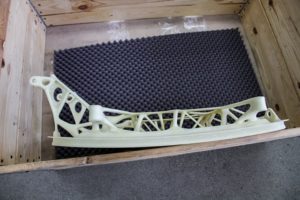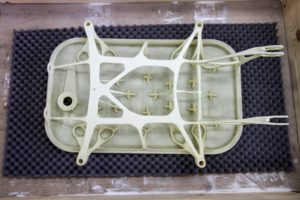Flying can be a sublime experience, especially when the plane’s design has been carefully considered and executed. Despite our human instinct to believe that supremely heavy objects such as planes or ships should neither fly nor float, their engineering allows them to do so and to the end user, it can seem nearly effortless. The reality is, however, that despite our decided ability to create planes and ships, there is still a great deal of human ingenuity being applied to the enhancement of their appearance and performance, from interior design to exterior styling and from inner engine workings to highly visible functional components.
It is in this vein that Sogeclair Aerospace, a French company with offices around the globe, has been working with voxeljet to unveil a new design for airplane doors, called the Optimdoor, that reduces their weight by 30%. The doors, which rely on 3D printed polymethyl methacrylate (PMMA) models from voxeljet, were unveiled at the Paris Aviation Show, where they were hailed as the aircraft door of the future.
But if airplanes are flying perfectly well with the doors they have now, why modify their design at all? One of the key benefits from reducing the weight is an increase in fuel efficiency and as engineers have been working the problem of weight reduction for some time, the introduction of 3D printing’s capabilities to print in titanium or aluminum using material-saving geometries has been quite welcome. Thierry Herrero, West Europe Sales Director for voxeljet, described the benefits of utilizing this technology:
“In this case, 3D printing can be combined with well-tried precision casting. This combines the best of both worlds: the geometric freedom of 3D printing and the stability of classic precision casting.”
Clearly, making the doors out of styrofoam would reduce their weight significantly, but the tricky part about these kinds of designs is that there must be a perfect marriage between weight reduction and performance. The use of 3D printing has been a breakthrough and voxeljet has developed a large-scale 3D printer, the VX1000 3D printing system with a print bed of 1000 x 600 x 500 mm, that allows them to fully take advantage of the opportunities presented by 3D printing at a scale that makes it viable to work with components as large as these. Another benefit of 3D printing is the ability it provides for rapid prototyping and quick turnaround on iterations. Combine these two factors and the timeline for enhanced aerospace components is greatly advanced. As Herrero explained:
“For the development of prototypes, companies must make repeated refinements. It is certainly timely and cost consuming with each change requiring the production of a new mould for the precision casting.”
- Side view of the 3D printed model. The bionic structures can be seen clearly.
- voxeljet prepares the printed and waxed model for shipment.
The door itself is fabricated by running the printhead over the blueprint in layers 150 micrometers thick, building up the precision casting model layer by layer. Once the model has been printed, it is then impregnated with wax to seal the surfaces, after which the piece is taken to the foundry where it is covered in layers of ceramic and smelted in a furnace. The ceramic mold is then filled with liquid aluminum which, once cooled, is beaten out of the mold and finished. The reduction in weight comes not in materials but from the creation of strength through a network of aluminum struts rather than relying on the heavy-duty strength of solid materials.
The door is currently still in its prototype phase, but was received with positive acclaim at the Paris Aviation Show, giving the green light to continue moving forward with its development.
What do you think of this news? Let us know your thoughts; join the discussion of this and other 3D printing topics at 3DPrintBoard.com or share your thoughts below.
[Source/Images: voxeljet]
Subscribe to Our Email Newsletter
Stay up-to-date on all the latest news from the 3D printing industry and receive information and offers from third party vendors.
You May Also Like
3D Printing Unpeeled: New Arkema Material for HP, Saddle and Macro MEMS
A new Arkema material for MJF is said to reduce costs per part by up to 25% and have an 85% reusability ratio. HP 3D HR PA 12 S has been...
3D Printing News Briefs, January 20, 2024: FDM, LPBF, Underwater 3D Printer, Racing, & More
We’re starting off with a process certification in today’s 3D Printing News Briefs, and then moving on to research about solute trapping, laser powder bed fusion, and then moving on...
3D Printing Webinar and Event Roundup: December 3, 2023
We’ve got plenty of events and webinars coming up for you this week! Quickparts is having a Manufacturing Roadshow, America Makes is holding a Member Town Hall, Stratafest makes two...
Formnext 2023 Day Three: Slam Dunk
I’m high—high on trade show. I’ve met numerous new faces and reconnected with old friends, creating an absolutely wonderful atmosphere. The excitement is palpable over several emerging developments. The high...



































